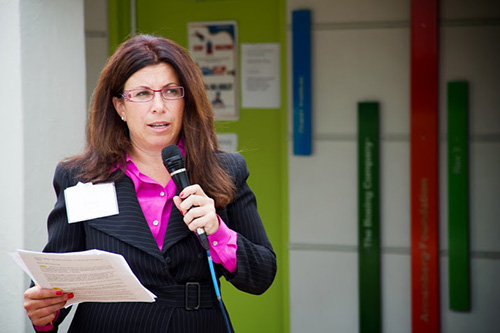
Most of us have huffed "That's not fair" at least once in our lives -- but seldom does it lead to any kind of meaningful action. However, an experience back in her middle school days in which Alison Suffet-Diaz felt she had been unfairly treated by a teacher left an indelible impression on the youngster and was the impetus behind a lifelong passion that ultimately led to her role as a key player in a groundbreaking education movement with her Environmental Charter Schools.
After graduating college with a degree in business economics, Diaz's pursuit of fairness, justice and equality took her to law school where she had her first taste of teaching and the satisfaction of making a positive impact on young people's lives by teaching inner-city youth about their constitutional rights.
Alison says, "I quickly learned that you can't lecture to kids and expect them to learn. The LEAP program taught us how to engage students in learning through role playing and other types of interactive activities." After law school, Diaz returned to 'the scene of the crime,' her former middle school to teach. There she employed this novel teaching concept by having her students conduct mock trials.
Diaz later moved to California and worked two years as an education law attorney. Serendipity came into play during this time as California's charter school law was enacted, paving the way for alternative types of public schools in the state. Little did she know then what an important role this legislation would soon play in her life.
Encouraged by a boss who recognized her passion for education, Diaz left her law career to teach and her pioneering spirit began to emerge. During an eight-year tenure teaching at Leuzinger High School in Lawndale, Calif., Diaz secured a California Partnership Academy Grant to create 'a school within a school' called Environmental Careers Academy (ECA).
"We raised additional funds by partnering with several environmental groups, which enabled us to expand our programs," Diaz noted. "Our students responded fabulously and their performance improved year after year."
Despite these successes, Diaz felt stifled by the bureaucracy inherent in traditional education systems. While attending a conference, someone suggested that she start her own school. That simple suggestion began her road toward creating what today is a growing network of innovative public charter schools, Environmental Charter Schools (ECS).
From 1999 through 2000, Diaz worked part time while she assembled a team of parents, teachers and business partners to support her during the process of petitioning to establish a new charter school. "I realized very quickly that I needed to find the right mentors to help me navigate the 'white waters'," Diaz said. "Every challenge was new. I had to learn how to effectively manage conflict. I learned that you have to give people an opportunity to say 'no'."
One of her earliest supporters and mentors was Lawndale School District Superintendent Joe Condon. Dr. Condon coached Diaz through the arduous grant-writing and petitioning process. After securing its first grant for $35,000 and charter approval in 2000, Environmental Charter High School (ECHS) was official.
"We worked day and night on a shoe-string budget for two years to secure the charter, prepare the facility, recruit students and staff, and develop the curriculum. Our commitment stems from years of attempting school reform within large, comprehensive schools entrenched in tradition, and too slow to respond to kids' needs. Despite some well intentioned teachers, many students did not even make it to graduation, and of those who did, most graduated without a connection to the wider world, without a sense of their own purpose to guide their future. This is why we started Environmental Charter High School."
Her Biggest Challenge:
"Our biggest challenge in those early years was forging the path between the vision of the school we wanted and the on-the-ground reality of where we were starting. While we had dreamt of a school that promoted personal responsibility over rules, we soon came to realize that responsibility had to be taught and that students could not learn in chaos. While we had envisioned a school managed by consensus, we came to accept that the leader sometimes has to make decisions and that keeping everyone happy was neither possible nor desirable. While we had hoped for a school that went beyond the classroom walls and allowed students to learn by doing, we had to make our peace with textbooks, standardized exams and classroom lectures. We worked hard to maintain the vision, while figuring out how to make it a reality."
"The learning curve was steep, but we stayed the course. Today, while we continue growing, evolving, re-evaluating and adapting strategies that are transforming our vision into reality, we have remained true to our original mission to equip all students with the knowledge and skills to graduate from college, to inspire them to discover their own sense of purpose and to empower them to become quality stewards of their community and world."
Originally, ECS starting with just one hundred ninth grade students on a temporary, shared campus, ECS now serves more than a thousand 6th through 12th grade students on three campuses.
Success is the Best Revenge:
"Many of our students, most of whom come from households below the poverty line and from families who have never attended college, start out more than two years below their respective grade levels. After two years in an ECS school, they have caught up to or surpassed their grade level. Ninety eight percent of ECHS graduates complete the coursework necessary for admission to a four-year college or university, compared to thirty five percent statewide. It's exhausting, but the most gratifying work I can imagine doing,"
Alison Explains A Bit About the Non-Profit Structure:
*Non profits, just as traditional school districts and cities and states, are businesses. There is revenue and expenses and they must be managed to achieve the mission of the organization. How you manage should be to the mission so if you are going to spend 100K of a $10 million dollar budget on field trips or on a particular program, that program should help to bring the organization a step closer to reaching its mission.
*Owners in the non profit sector are different, it's the stakeholders of the organization, the community the organization serves and the public interest that the non-profit was born to help/provide for who are the "owners. The non profit's profits do not get paid as dividend to the owners but instead are continually reinvested in the organization to achieve the mission.
*You do not "get rich" in education or in the non profit sector. It's not about the money. Its about the mission, vision and goals of the organization. It's really more of a labor of love. When folks ask me, "Do I own the schools?" No, I don't. If the ECS board of directors thought I wasn't doing the organization justice, I could be let go. I am an at will employee. I have to trust that the organization board of directors will continue to see the value I bring to the organization. I don't own it; I founded it.
Alison's Advice to Those Dreaming of a Similar Path:
- It has to be your passion.
- Expect to work harder than you've ever worked in your life or that you ever thought you could.
- Get used to hearing 'no.'
- Graciously never take 'no' for an answer.
- Surround yourself with great people who are as committed to the vision as you are.
That fateful day back in middle school has come full circle to benefit many other teens now. Alison's sweat equity continues to be an asset as she provides a business model to other communities as well.
